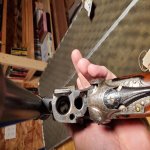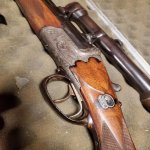Appx 37 years ago I had to sell off my Drilling, chambered for the 16ga over 8x57JR.
It was a beauty, brought back after the WWII occupation of West Germany, by a good friend and mentor. He had done something, which kept him on active duty right up to 1948. He had a document from his commanding officer and the home office to bring the rifle back to Canada with him.
OP, the rifle was very similar to the one in your excellent pics.
He passed away, from Cancer in 1975 and gave me the rifle as a memento of our friendship before he passed. I had been handloading the ammo for it.
Anyway, to make a long story short, brass was really difficult to find and loaded ammunition was even rarer.
I used to neck up 303 British cases and fireform them in the Drilling. This actually worked very well. Only about .005 in difference at the head diameter, which is about similar to most once fired cases, from a Lee Enfield.
Sourcing bullets didn't seem to be a problem back then, CIL made them in nice little boxes of 50, in plastic trays to keep them separated. They made them in 3 different weights and shapes. 150/170/196 grain. They could all be had in either round nose or flat base spitzer type.
I only loaded the 150 grain, .318 diameter, flat base, round nose bullets for that lovely Drilling. It had a rather slow twist rate, about 1-12 and didn't like heavier bullets at the velocities we felt were safe.
Those bullets were on the shelf of Les Viel's Gun Shop in Vernon, back in those days. Now they would have to be special order I suspect.
I had two go to powders at the time, that worked in just about everything I had. IMR4320 and IMR4350
I used the starting loads in the Hornady First manual, printed in 1967.
44.0 grains of IMR4320 over Standard LR primers, under 150 grain round nose bullets.
The next powder of choice was 51.0 grains of IMR4350 over Standard LR primers, under 150 grain round nose bullets.
We tried some 170 grain round nose, to see if they shot any better. They didn't and like most Drillings the felt recoil was markedly greater. So we just loaded it with light bullets.
I liked to use the IMR4350 because it filled the case better. This was a problem with that Drilling as it had a lot of free bore and bullets were seated to the junction of the shoulder/neck.
We calculated velocities by measuring bullet drop at different ranges in those days. Only very well heeled individuals could afford a Chronograph in those days.
The period scope on the rifle was a Koehler 3X and was mounted exactly like the scope in your pics. Windage adjustment was on the rear base. Parallax was brutal at best and you had to hold your head high and at the same position to keep the groups below 4 inches at a hundred yards.
We shot a lot of game with that Drilling, I miss Walt Rogers and Les Viel a lot. Tiny Tim Ryan showed me how to use size and fireform the 303 Brit cases for it, at Les Viel's request.
I still have one Drilling tucked away in my safe. I bring it out occasionally and take it to the range, for nostalgic purposes. It's a 16ga double, over 9.3x74R. Very light and handy but the recoil isn't pleasant. It has the same mounts but a modern scope sits in the rings.














































































